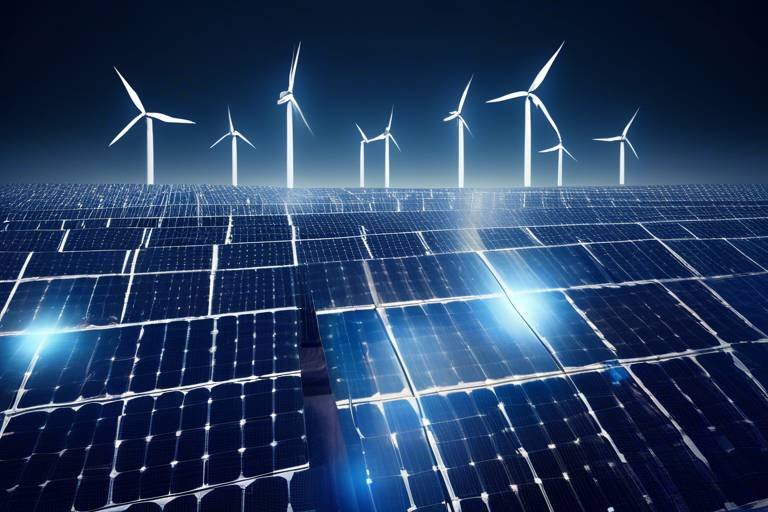The Contribution of AI in Advancement of Renewable Energy
In recent years, the renewable energy sector has witnessed a seismic shift, largely driven by the integration of artificial intelligence (AI). This technological revolution is not just about making things faster; it's about making them smarter. Imagine a world where energy systems can predict demand, optimize resources, and even prevent failures before they happen. Sounds like science fiction? Well, it's happening right now! AI is transforming how we harness renewable energy, paving the way for a more sustainable future. From solar and wind energy to hydroelectric power, the impact of AI is profound and far-reaching.
One of the most exciting aspects of AI in renewable energy is its ability to analyze vast amounts of data in real-time. Think of it as having a super-intelligent assistant that can sift through mountains of information to find patterns and insights that would take humans ages to uncover. This not only enhances efficiency but also reduces costs, making renewable energy sources more competitive against traditional fossil fuels. By optimizing energy consumption and production, AI-driven systems are helping us move towards a greener planet, one calculation at a time.
Moreover, the benefits of AI extend beyond just operational efficiency. It plays a crucial role in predictive maintenance, energy forecasting, and smart grid management. By leveraging machine learning algorithms, we can foresee potential equipment failures, accurately predict energy output based on weather conditions, and manage energy distribution more effectively. The result? A more resilient and reliable energy infrastructure that meets the demands of a growing population.
As we delve deeper into the various applications of AI in the renewable energy sector, we'll uncover how this technology is not just a trend but a vital component of the industry's future. Buckle up, because the journey ahead is filled with innovation, sustainability, and a commitment to a cleaner, greener world.
- What is AI's role in renewable energy? AI optimizes energy consumption, predicts maintenance needs, and enhances forecasting accuracy, contributing to a more efficient renewable energy sector.
- How does predictive maintenance work? Predictive maintenance uses AI to analyze historical data and predict when equipment will need servicing, thereby reducing downtime and costs.
- What are smart grids? Smart grids are advanced electrical grids that use AI to manage energy flow in real-time, improving reliability and efficiency.
- How does AI enhance energy forecasting? AI analyzes weather patterns and historical data to provide accurate energy output predictions, aiding in better resource management.

AI-Driven Energy Management Systems
In the ever-evolving landscape of renewable energy, are emerging as game-changers. These systems are not just about crunching numbers; they are about transforming how we consume and produce energy. Imagine a conductor leading an orchestra, where each instrument plays in perfect harmony. That’s what AI does for energy management—it synchronizes various energy sources, consumption patterns, and storage solutions to create an efficient system.
At the heart of these AI-driven systems lies the ability to analyze vast amounts of data in real-time. This means they can monitor energy usage patterns, predict future demands, and adjust supply accordingly. For instance, during peak hours when energy demand skyrockets, AI can optimize the energy flow from renewable sources like solar and wind, ensuring that we utilize our resources efficiently. This not only leads to cost savings for consumers but also enhances the overall sustainability of our energy systems.
One of the standout features of these systems is their ability to integrate with existing technologies. By leveraging the Internet of Things (IoT), AI can connect with smart devices in homes and businesses, creating a seamless energy management experience. For example, consider a smart thermostat that learns your heating preferences and adjusts the temperature accordingly. When integrated with AI, it can also factor in real-time energy prices, weather forecasts, and even your daily schedule to optimize energy usage. This level of personalization not only improves comfort but also significantly reduces energy bills.
Another critical aspect of AI-driven energy management systems is their role in energy storage optimization. With the increasing reliance on renewable energy sources, effective energy storage solutions are essential. AI can predict when energy production will peak and when demand will drop, allowing for smarter charging and discharging of batteries. This ensures that energy is available when needed, reducing waste and maximizing the use of renewable resources.
To illustrate the impact of AI on energy management, consider the following table that outlines the benefits of AI integration:
| Benefit | Description |
|---|---|
| Increased Efficiency | Optimizes energy consumption and reduces waste. |
| Cost Savings | Reduces energy bills through smarter usage patterns. |
| Enhanced Sustainability | Promotes the use of renewable energy sources. |
| Real-Time Adaptation | Adjusts energy distribution based on current demand and supply. |
In summary, AI-driven energy management systems are not just a trend; they are the future of energy consumption and production. By harnessing the power of AI, we can create a more efficient, sustainable, and cost-effective energy landscape. As we continue to innovate and integrate these technologies, the potential for a greener future becomes more attainable. So, are you ready to embrace the AI revolution in energy management?

Predictive Maintenance in Renewable Energy
In the ever-evolving landscape of renewable energy, predictive maintenance powered by artificial intelligence is emerging as a game-changer. Imagine having the ability to foresee potential equipment failures before they disrupt operations—this is precisely what AI brings to the table. By leveraging advanced analytics and historical data, AI can forecast when maintenance is needed, allowing energy facilities to operate more smoothly and efficiently. This proactive approach not only minimizes unexpected downtime but also significantly reduces maintenance costs, creating a win-win situation for energy providers and consumers alike.
So, how does this all work? At the heart of predictive maintenance are machine learning algorithms that sift through vast amounts of data to identify patterns and anomalies. Think of it as having a highly skilled detective on your team, constantly analyzing clues (data) to solve a mystery (predict equipment failures). This capability is crucial in the renewable energy sector, where the reliability of assets such as wind turbines and solar panels directly impacts energy production and, consequently, profitability.
Machine learning algorithms play a significant role in enhancing predictive maintenance strategies. They can process large datasets collected from various sources, including sensors installed on equipment. These sensors continuously monitor the health of machinery, feeding real-time data back to the AI systems. With this information, AI can detect subtle changes in performance that may indicate a looming failure. For example, if a wind turbine's vibration levels start to deviate from the norm, the system can alert maintenance teams to investigate before a complete breakdown occurs.
Effective data collection is the backbone of successful predictive maintenance. Utilizing Internet of Things (IoT) devices and sensors, renewable energy facilities can gather real-time data on equipment performance. This data includes everything from temperature and humidity to vibration and operational speed. The more comprehensive the data collection, the more accurate the AI's predictions become. By implementing robust data collection techniques, energy providers can ensure that their predictive maintenance strategies are grounded in solid, actionable insights.
The impact of AI-driven predictive maintenance on operational efficiency cannot be overstated. By anticipating equipment failures, facilities can schedule maintenance during off-peak hours, ensuring that energy production remains uninterrupted. This not only enhances the reliability of renewable energy systems but also extends the lifespan of valuable assets. For instance, a solar panel that receives timely maintenance can operate at peak efficiency for years longer than one that is neglected. In essence, predictive maintenance acts as a safeguard, protecting investments and promoting sustainability in the renewable energy sector.
As we navigate toward a more sustainable future, the role of predictive maintenance in renewable energy becomes increasingly vital. By embracing AI technologies, energy providers can optimize their resources, reduce costs, and ultimately contribute to a greener planet. The synergy between AI and renewable energy is not just a trend; it's a transformative movement that promises to redefine how we approach energy management.
In conclusion, the integration of predictive maintenance powered by AI is revolutionizing the renewable energy landscape. By harnessing the power of data and machine learning, energy facilities can enhance their operational efficiency, reduce costs, and ensure a more reliable energy supply. As we continue to innovate and adapt, the future of renewable energy looks brighter than ever.
- What is predictive maintenance? Predictive maintenance is a proactive maintenance strategy that uses data analysis and AI to predict when equipment failures might occur, allowing for timely interventions.
- How does AI improve predictive maintenance? AI enhances predictive maintenance by analyzing historical and real-time data to identify patterns, enabling better forecasting of maintenance needs.
- What are the benefits of predictive maintenance in renewable energy? The benefits include reduced downtime, lower maintenance costs, improved operational efficiency, and extended lifespan of equipment.
- What role do IoT devices play in predictive maintenance? IoT devices collect real-time data from equipment, which is essential for AI systems to analyze performance and predict failures accurately.

Machine Learning Algorithms
Machine learning algorithms have become the backbone of predictive maintenance in the renewable energy sector. These algorithms are designed to learn from data, identify patterns, and make decisions with minimal human intervention. Imagine having a digital assistant that not only understands your preferences but also predicts your needs before you even express them. This is essentially what machine learning does for renewable energy systems. By processing vast amounts of historical and real-time data, these algorithms can detect anomalies that might indicate potential equipment failures.
In the context of renewable energy, machine learning algorithms analyze data from various sources, including weather conditions, energy production metrics, and equipment performance logs. For instance, consider a wind turbine; machine learning can evaluate its operational data against historical performance to predict when maintenance should occur, thereby preventing costly downtimes and ensuring optimal performance. This proactive approach enhances the reliability of renewable energy systems, as it allows for timely interventions that keep everything running smoothly.
To illustrate the impact of machine learning algorithms further, let's take a look at some key benefits:
- Enhanced Predictive Capabilities: Machine learning can analyze complex datasets to identify trends that might not be immediately obvious to human analysts.
- Reduced Maintenance Costs: By predicting failures before they happen, companies can avoid expensive emergency repairs and extend the lifespan of their equipment.
- Improved Energy Efficiency: These algorithms help optimize energy production by ensuring that resources are used effectively, reducing waste.
Furthermore, the integration of machine learning with IoT devices allows for continuous monitoring and data collection. Sensors installed on renewable energy assets provide real-time information, which is crucial for the algorithms to function effectively. This synergy between machine learning and IoT creates a smart ecosystem where data flows seamlessly, enabling organizations to make informed decisions that enhance operational efficiency.
In summary, machine learning algorithms are not just a trend; they are a transformative force in the renewable energy sector. By leveraging these advanced technologies, companies can ensure that their systems are not only efficient but also resilient, paving the way for a more sustainable energy future. As we continue to innovate and integrate these technologies, the potential for renewable energy to meet global demands becomes even more promising.
- What are machine learning algorithms?
Machine learning algorithms are computational methods that allow systems to learn from data, identify patterns, and make predictions without being explicitly programmed. - How do machine learning algorithms improve predictive maintenance?
These algorithms analyze historical performance data to predict when equipment is likely to fail, allowing for timely maintenance and reducing unexpected downtimes. - Can machine learning algorithms be used in other sectors?
Absolutely! Machine learning is utilized across various industries, including healthcare, finance, and manufacturing, to optimize processes and improve outcomes.

Data Collection Techniques
In the realm of renewable energy, effective are the backbone of successful AI implementation. These techniques not only ensure that accurate information is gathered but also facilitate the analysis needed for predictive maintenance and operational efficiency. Imagine trying to navigate without a map; that's what energy management would be like without reliable data. The advent of sensors and Internet of Things (IoT) devices has transformed the way we collect data in this sector, allowing for real-time monitoring and analysis.
One of the most significant advancements in data collection involves the use of smart sensors. These devices are strategically placed throughout renewable energy facilities, such as solar farms and wind turbines, to capture a plethora of data points. From temperature and humidity to energy output and equipment vibration, these sensors create a comprehensive picture of operational health. For instance, a wind turbine equipped with smart sensors can provide continuous feedback on its performance, alerting operators to any anomalies that may indicate potential failures.
Moreover, the integration of IoT technology enhances the capabilities of data collection. By connecting various sensors and devices to the internet, operators can access real-time data remotely. This connectivity allows for immediate response to any issues that arise, which is crucial in minimizing downtime. In fact, a study found that facilities utilizing IoT for data collection experienced a reduction in operational costs by up to 30% due to improved efficiency and faster response times.
To illustrate the importance of these data collection techniques, consider the following table that outlines some common methods and their applications in renewable energy:
| Data Collection Method | Description | Application |
|---|---|---|
| Smart Sensors | Devices that monitor various parameters in real-time | Wind turbines, solar panels, and energy storage systems |
| IoT Devices | Connected devices that transmit data over the internet | Remote monitoring and control of energy systems |
| Satellite Imagery | Use of satellite data to assess solar and wind resources | Site assessment for new renewable energy projects |
| Weather Stations | Instruments that collect meteorological data | Energy forecasting and resource optimization |
In summary, the integration of advanced data collection techniques is pivotal in harnessing the power of AI in renewable energy. As we continue to innovate and improve these methods, the potential for enhanced efficiency and sustainability grows exponentially. By leveraging data from smart sensors and IoT devices, the renewable energy sector is not only becoming more efficient but is also paving the way for a greener future.
- What role do sensors play in renewable energy? Sensors are crucial for monitoring various parameters in real-time, helping to identify issues before they escalate.
- How does IoT enhance data collection? IoT connects devices to the internet, allowing for remote monitoring and immediate response to operational changes.
- What are the benefits of using advanced data collection techniques? These techniques improve operational efficiency, minimize downtime, and reduce costs associated with maintenance.

Impact on Operational Efficiency
The implementation of AI-driven predictive maintenance in renewable energy facilities has a profound . By leveraging advanced algorithms and data analytics, AI can help identify potential equipment failures before they occur. This proactive approach not only minimizes unexpected downtimes but also extends the lifespan of renewable energy assets. Imagine a wind turbine that can alert operators about potential mechanical issues before they escalate into costly repairs—this is the power of AI in action.
Moreover, the integration of AI into maintenance strategies allows for a more strategic allocation of resources. Rather than adhering to a fixed maintenance schedule, which may lead to unnecessary inspections or missed issues, AI analyzes real-time data to determine the optimal times for maintenance. This results in significant cost savings and ensures that the energy facilities operate at peak performance.
To illustrate the benefits, consider the following table that highlights key improvements in operational efficiency due to AI integration in renewable energy systems:
| Aspect | Before AI Integration | After AI Integration |
|---|---|---|
| Downtime | 15% annually | 5% annually |
| Maintenance Costs | $500,000 | $300,000 |
| Asset Lifespan | 10 years | 15 years |
As you can see, the numbers speak volumes. The reduction in downtime from 15% to just 5% is a game-changer. Not only does it save money, but it also enhances the reliability of energy production. The extended lifespan of assets means that investments in renewable energy technologies yield better returns over time.
In addition to financial benefits, AI also fosters a culture of continuous improvement within organizations. With access to real-time data and analytics, teams can make informed decisions that lead to ongoing enhancements in processes and operations. This creates a ripple effect, where efficiency gains lead to better energy production, lower costs, and ultimately, a more sustainable energy future.
In conclusion, the impact of AI on operational efficiency in renewable energy is not just a trend; it is a significant advancement that reshapes how energy facilities operate. By embracing these technologies, the industry can look forward to a future that is not only more efficient but also more resilient and sustainable.
- What is predictive maintenance?
Predictive maintenance is a proactive approach that uses AI and data analytics to predict equipment failures before they happen, allowing for timely interventions. - How does AI improve operational efficiency?
AI optimizes maintenance schedules, reduces downtime, and extends the lifespan of equipment, leading to significant cost savings and improved reliability. - Can AI be integrated into existing renewable energy systems?
Yes, AI can be integrated into existing systems through sensors, IoT devices, and software solutions that analyze data in real-time.

Benefits of AI in Energy Forecasting
When it comes to energy forecasting, the integration of artificial intelligence (AI) is nothing short of a game-changer. Imagine having a crystal ball that not only predicts energy demand but also adjusts supply accordingly. That's precisely what AI does in the realm of renewable energy. By analyzing vast amounts of data—from weather patterns to historical usage trends—AI enhances forecasting accuracy, which is crucial for effective energy resource management.
One of the standout benefits of AI in energy forecasting is its ability to process real-time data. Traditional forecasting methods often rely on static models that can quickly become outdated. However, AI algorithms continuously learn and adapt, allowing them to respond to real-time changes in energy consumption and supply. This adaptability ensures that energy providers can optimize their resources, reducing waste and improving overall efficiency.
Moreover, AI's predictive capabilities extend beyond mere forecasting. For instance, by analyzing historical weather data alongside current conditions, AI can predict not just how much energy will be needed, but also when it will be needed the most. This means that energy providers can ramp up production in anticipation of spikes in demand, rather than scrambling to catch up once the demand has already surged. Such proactive measures are crucial for maintaining a stable energy supply, especially during peak times.
To illustrate the impact of AI on energy forecasting, consider the following table that highlights key benefits:
| Benefit | Description |
|---|---|
| Increased Accuracy | AI models analyze complex datasets to provide more accurate energy demand forecasts. |
| Real-Time Adjustments | AI enables real-time monitoring and adjustments based on changing energy consumption patterns. |
| Cost Savings | Improved forecasting reduces operational costs by optimizing resource allocation. |
| Enhanced Integration | AI facilitates better integration of renewable energy sources into the grid, improving reliability. |
In addition to these benefits, AI also plays a crucial role in fostering collaboration among various stakeholders in the energy sector. By providing accurate forecasts, AI helps utilities and renewable energy providers work together more effectively, ensuring that energy production aligns with consumption needs. This collaborative effort is vital for enhancing the overall sustainability of energy systems.
Ultimately, the advantages of AI in energy forecasting extend beyond just operational efficiency. They contribute to a more sustainable energy future, where resources are used wisely, and renewable energy sources are maximized. As we continue to face the challenges of climate change, the role of AI in energy forecasting will only become more critical, paving the way for a greener, more resilient energy landscape.
- What is AI in energy forecasting? AI in energy forecasting refers to the use of artificial intelligence algorithms to predict energy demand and supply based on various data inputs.
- How does AI improve accuracy in energy forecasting? AI improves accuracy by analyzing large datasets, recognizing patterns, and continuously learning from real-time data.
- What are the benefits of using AI for energy resource management? Benefits include increased accuracy, real-time adjustments, cost savings, and enhanced integration of renewable energy sources.
- Can AI help reduce energy waste? Yes, by providing accurate forecasts and optimizing resource allocation, AI can significantly reduce energy waste.

Smart Grids and AI Integration
As we delve into the fascinating world of smart grids and their integration with artificial intelligence (AI), it's essential to understand how this combination is reshaping the energy landscape. Smart grids are essentially the nervous system of our energy infrastructure, allowing for real-time communication between energy producers and consumers. With AI at the helm, these grids become even more dynamic, capable of adapting to fluctuations in energy demand and supply with remarkable precision.
Imagine a bustling city where energy needs fluctuate throughout the day, much like the ebb and flow of a busy marketplace. In this scenario, AI acts as a savvy market manager, analyzing real-time data from various sources—like energy consumption patterns, weather forecasts, and grid status—to optimize energy distribution. This means that during peak hours, when the demand skyrockets, AI can efficiently reroute energy from less-utilized sources, ensuring that every light stays on without breaking a sweat.
One of the standout features of AI integration in smart grids is real-time data analysis. By continuously monitoring energy flow, AI algorithms can detect anomalies or inefficiencies almost instantaneously. For instance, if a particular area is consuming more energy than usual, the system can quickly adjust to prevent overloads or outages. This capability not only enhances the reliability of energy distribution but also contributes significantly to the overall efficiency of renewable energy sources.
Furthermore, AI-driven smart grids foster consumer engagement in unprecedented ways. Imagine receiving notifications on your smartphone about your energy usage in real-time, along with personalized tips on how to save energy during peak times. This level of engagement encourages consumers to adopt demand response strategies, which are essential for balancing supply and demand. By actively participating in energy conservation efforts, consumers can help stabilize the grid while also saving on their energy bills.
To illustrate the impact of AI in smart grids, consider the following table that highlights the key benefits:
| Benefit | Description |
|---|---|
| Enhanced Reliability | Real-time monitoring allows for quick responses to energy demand fluctuations. |
| Increased Efficiency | AI optimizes energy distribution, reducing waste and improving resource management. |
| Consumer Empowerment | Real-time data helps consumers make informed decisions about their energy consumption. |
In summary, the integration of AI into smart grids represents a significant leap towards a more sustainable and efficient energy future. By harnessing the power of real-time data and consumer engagement, we can create a resilient energy ecosystem that not only meets our current needs but also paves the way for future innovations. As we embrace this technology, we move closer to a world where renewable energy isn't just an alternative but the norm.
- What is a smart grid? A smart grid is an electricity supply network that uses digital technology to monitor and manage the transport of electricity from all generation sources to meet the varying electricity demands of end users.
- How does AI improve smart grids? AI enhances smart grids by enabling real-time data analysis, optimizing energy distribution, and improving consumer engagement through personalized energy usage information.
- What are the benefits of integrating AI into renewable energy systems? The benefits include increased reliability, improved efficiency, reduced operational costs, and enhanced consumer participation in energy conservation efforts.

Real-Time Data Analysis
In the fast-paced world of renewable energy, has emerged as a game-changer. Imagine a bustling marketplace where vendors can instantly adjust their prices based on demand fluctuations—this is akin to how smart grids operate with real-time data. By harnessing the power of artificial intelligence, these systems can monitor energy flow continuously, adapting to changes in supply and demand almost instantaneously. This capability not only enhances efficiency but also ensures that energy distribution is optimized, preventing wastage and maximizing resource utilization.
At the heart of this real-time analysis is a network of sensors and IoT devices that collect data from various sources, including weather forecasts, energy consumption patterns, and grid performance metrics. These devices feed information into AI algorithms, which process and analyze the data to generate actionable insights. For instance, if a sudden increase in energy demand is detected, AI can quickly adjust the distribution of power to meet this surge, ensuring a stable energy supply. This dynamic response is crucial in preventing blackouts and maintaining grid reliability.
Furthermore, real-time data analysis empowers energy producers and consumers alike. Consumers gain access to their energy usage patterns, allowing them to make informed decisions about their consumption habits. This transparency fosters a culture of energy conservation, as users can see the direct impact of their choices on their bills and the environment. On the production side, energy providers can forecast demand more accurately, leading to better planning and resource allocation.
To illustrate the significance of real-time data analysis in renewable energy, consider the following table that outlines its key benefits:
| Benefit | Description |
|---|---|
| Enhanced Efficiency | Real-time adjustments to energy distribution minimize losses and optimize resource use. |
| Improved Reliability | Dynamic responses to demand fluctuations help prevent outages and maintain grid stability. |
| Consumer Empowerment | Access to real-time data encourages users to modify their consumption behaviors for better savings. |
| Accurate Forecasting | AI-driven predictions based on real-time data lead to more effective energy planning. |
In conclusion, the integration of real-time data analysis into renewable energy systems is not just a technological advancement; it's a necessary evolution in how we manage and consume energy. As we continue to leverage AI's capabilities, the potential for creating a more sustainable and efficient energy landscape becomes increasingly tangible. The future of energy is here, and it's powered by real-time insights.
- What is real-time data analysis in renewable energy?
Real-time data analysis involves continuously monitoring and analyzing energy data to optimize energy distribution and consumption. - How does AI contribute to real-time data analysis?
AI processes vast amounts of data from various sources, enabling smart grids to respond dynamically to changes in energy demand and supply. - Why is real-time data analysis important for consumers?
It provides consumers with insights into their energy usage, helping them make informed decisions that can lead to cost savings and energy conservation. - Can real-time data analysis prevent power outages?
Yes, by allowing energy providers to adjust distribution in response to demand fluctuations, it helps maintain grid stability and prevent outages.

Consumer Engagement and Demand Response
In today’s energy landscape, consumer engagement is more critical than ever. As renewable energy sources like solar and wind become more prevalent, the need for consumers to actively participate in energy management is paramount. AI-driven smart grids are revolutionizing this interaction by providing real-time data that empowers consumers to make informed decisions about their energy usage. Imagine being able to see your energy consumption in real-time, just like checking your social media feed! This instant feedback not only raises awareness but also motivates individuals to adjust their habits, leading to significant energy savings.
One of the most exciting aspects of AI in consumer engagement is the concept of demand response. This strategy encourages consumers to reduce or shift their energy usage during peak periods. For example, during a hot summer day when everyone cranks up their air conditioning, AI can send notifications to consumers, suggesting they lower their thermostat by a couple of degrees. This not only helps to alleviate pressure on the grid but also rewards consumers with lower energy bills. It’s a win-win situation! Through demand response programs, consumers can actively contribute to a more sustainable energy future while benefiting from financial incentives.
Moreover, AI systems can analyze individual consumption patterns and suggest personalized strategies for energy savings. For instance, if an AI system notices that a household consistently uses more energy during certain hours, it might recommend shifting some activities, like running the dishwasher, to off-peak times. This tailored approach makes energy management feel less like a chore and more like a personalized service. It’s akin to having a personal trainer for your energy use, guiding you towards better habits and efficiency.
To further illustrate the impact of consumer engagement and demand response, consider the following table that outlines the benefits of these AI-driven initiatives:
| Benefit | Description |
|---|---|
| Increased Awareness | Real-time data helps consumers understand their energy consumption patterns. |
| Cost Savings | Participating in demand response programs can lead to lower energy bills. |
| Grid Stability | Reduces strain on the grid during peak demand times, enhancing reliability. |
| Environmental Impact | Encourages the use of renewable energy sources, reducing carbon footprints. |
In summary, the integration of AI into consumer engagement and demand response not only enhances the efficiency of energy consumption but also fosters a community of informed and proactive energy users. As we move towards a more sustainable future, it’s clear that the role of consumers will be pivotal. By embracing these technologies, we can all contribute to a greener planet, one smart decision at a time.
- What is consumer engagement in energy management?
Consumer engagement refers to the active participation of individuals in managing their energy consumption, often facilitated by technology such as AI. - How does demand response work?
Demand response programs incentivize consumers to reduce or shift their energy usage during peak periods, helping to balance the supply and demand on the grid. - What are the benefits of using AI in energy management?
AI enhances efficiency, provides real-time data, encourages energy conservation, and helps consumers save on their energy bills. - Can I participate in demand response programs?
Yes, many utility companies offer demand response programs. Check with your local provider to see what options are available.

AI in Renewable Energy Research and Development
In the quest for a sustainable future, artificial intelligence (AI) has emerged as a game-changer in the field of renewable energy research and development. By harnessing the power of AI, researchers can simulate various scenarios and optimize design processes, leading to innovative solutions that were once thought to be out of reach. Imagine trying to navigate a maze blindfolded; AI acts like a guide, illuminating the path forward and helping us avoid dead ends in our quest for cleaner energy sources.
One of the most significant advantages of AI in this sector is its ability to process vast amounts of data quickly and accurately. This capability allows researchers to conduct advanced simulations and modeling techniques that can predict how new technologies will perform under different conditions. For instance, AI can analyze how solar panels will respond to varying weather patterns or how wind turbines can be optimized for specific geographical locations. This predictive power not only saves time but also reduces the costs associated with trial and error in the development phase.
Furthermore, AI fosters collaboration between established companies and innovative startups in the renewable energy landscape. By leveraging AI tools, startups can access resources and insights that were previously available only to larger organizations. This collaboration leads to a vibrant ecosystem where new ideas can flourish, driving innovation and creating new business opportunities. Think of it as a symbiotic relationship where both parties benefit, ultimately enhancing the entire industry.
To illustrate the impact of AI in research and development, consider the following table that highlights key areas where AI is making a difference:
| Area of Impact | Description |
|---|---|
| Simulation and Modeling | AI-driven simulations allow for testing of renewable technologies in virtual environments, significantly reducing development risks. |
| Data Analysis | AI analyzes historical data to identify trends, helping researchers make informed decisions about technology development. |
| Collaboration | AI tools facilitate partnerships between large firms and startups, fostering innovation and new business models. |
As we look toward the future, the potential of AI in renewable energy research and development is immense. By continuing to refine these technologies, we can expect to see breakthroughs that not only enhance efficiency but also make renewable energy sources more accessible and affordable for everyone. The journey towards a sustainable energy future is not just about the technologies we develop but also about how we leverage AI to push the boundaries of what is possible.
- How does AI improve renewable energy research?
AI enhances research by enabling advanced simulations, data analysis, and fostering collaboration, which accelerates the development of new technologies. - What are some examples of AI applications in renewable energy?
AI is used in predictive maintenance, energy forecasting, and optimizing the design of renewable energy systems. - Can AI reduce the costs of renewable energy development?
Yes, by minimizing trial and error and improving efficiency, AI can significantly lower development costs.

Simulation and Modeling Techniques
In the realm of renewable energy, powered by artificial intelligence (AI) are becoming game-changers. Imagine having the ability to visualize various energy scenarios before they even happen. This isn't just a dream—it's a reality made possible by advanced AI technologies. By using sophisticated algorithms, researchers can simulate how different renewable energy systems will perform under various conditions. This predictive capability allows for a more informed approach to energy management, ultimately leading to better decision-making.
One of the most significant advantages of these simulation techniques is their ability to reduce risks and costs associated with developing new technologies. For instance, when designing a new solar panel system, researchers can model how it will perform in different climates and under various weather conditions. This means they can identify potential issues and make adjustments before the system is even built. It's like having a crystal ball that shows you the future of your energy project!
Additionally, AI-driven simulations can analyze vast amounts of data from previous projects, allowing researchers to refine their models continually. This iterative process ensures that the simulations become increasingly accurate over time. For example, a recent study demonstrated that AI simulations improved the design efficiency of wind turbines by up to 30% by accurately predicting their performance in diverse environmental conditions.
The integration of machine learning further enhances these simulation techniques. By employing machine learning algorithms, researchers can uncover hidden patterns in data that traditional methods might overlook. This enables them to create more sophisticated models that can adapt to changing variables, such as fluctuating energy prices or unexpected technological advancements.
Here’s a brief overview of how simulation and modeling techniques are transforming renewable energy research and development:
| Technique | Description | Benefits |
|---|---|---|
| Scenario Simulation | Models various energy production scenarios based on different inputs. | Helps in risk assessment and strategic planning. |
| Performance Modeling | Predicts the performance of renewable energy systems under varying conditions. | Enhances design accuracy and operational efficiency. |
| Data-Driven Insights | Utilizes historical data to inform simulations. | Improves decision-making and innovation in technology. |
In conclusion, the impact of simulation and modeling techniques in the renewable energy sector cannot be overstated. As AI continues to evolve, these techniques will only become more sophisticated, paving the way for innovative solutions that can tackle the pressing challenges of energy production and sustainability. By harnessing the power of AI, we are not just predicting the future of renewable energy; we are actively shaping it.
- What are simulation and modeling techniques in renewable energy?
These are advanced methods that use AI to predict the performance of renewable energy systems under various conditions, helping to optimize design and reduce risks.
- How does AI improve simulation accuracy?
AI can analyze large datasets to identify patterns and trends that enhance the predictive capabilities of simulations, leading to more reliable results.
- Why are these techniques important for renewable energy?
They help in reducing costs, improving efficiency, and fostering innovation, ultimately contributing to a more sustainable energy future.

Collaboration with Renewable Energy Startups
In the rapidly evolving landscape of renewable energy, the collaboration between established companies and startups is not just beneficial; it’s essential. Startups often bring fresh ideas and innovative technologies to the table, while established companies offer the resources and experience needed to scale these solutions. This synergy can lead to groundbreaking advancements in the sector, ultimately accelerating the transition to a sustainable energy future.
One of the most exciting aspects of these collaborations is the potential for disruptive innovation. Startups are typically more agile and willing to take risks, allowing them to explore uncharted territories in renewable energy. For instance, a startup may develop a novel solar panel technology that significantly increases efficiency. When partnered with a larger company that has the manufacturing capabilities and distribution networks, this innovation can reach the market much faster than if the startup were to go it alone.
Moreover, collaborations can take various forms, including joint ventures, research partnerships, and funding arrangements. For example, large energy corporations might invest in promising startups through venture capital funds, providing them with the necessary capital to develop their technologies. In return, these corporations gain access to cutting-edge innovations that can enhance their existing operations. This win-win scenario creates a dynamic ecosystem where both parties thrive.
To illustrate the impact of these collaborations, consider the following table that highlights some successful partnerships in the renewable energy sector:
| Established Company | Startup | Collaboration Focus | Outcome |
|---|---|---|---|
| Company A | Startup X | Solar Technology | Increased efficiency by 25% |
| Company B | Startup Y | Energy Storage | Developed a new battery technology |
| Company C | Startup Z | Wind Turbine Design | Reduced costs by 30% |
These examples showcase how powerful synergies can emerge when established firms and startups join forces. Additionally, the collaboration often extends beyond just technology development. It can also encompass areas such as market access, policy advocacy, and customer engagement. By working together, they can tackle some of the most pressing challenges in the renewable energy space, such as regulatory hurdles and market penetration strategies.
In conclusion, the collaboration between established companies and renewable energy startups is a driving force behind the industry's growth and innovation. By leveraging each other's strengths, they can create solutions that not only meet today's energy demands but also pave the way for a sustainable future. As we move forward, fostering these partnerships will be crucial in overcoming the challenges that lie ahead in the quest for a greener planet.
- What are the benefits of collaboration between startups and established companies?
Collaborations can lead to faster innovation, increased resources, and better market access. Startups gain experience and funding, while established companies benefit from fresh ideas and technologies.
- How can startups attract established companies for collaboration?
Startups can showcase their innovative solutions through networking, participating in industry events, and demonstrating the potential impact of their technologies.
- What types of collaborations are most common in the renewable energy sector?
Common collaborations include joint ventures, research partnerships, and venture capital investments aimed at accelerating technology development and market entry.
Frequently Asked Questions
- How is AI transforming renewable energy?
AI is revolutionizing renewable energy by enhancing efficiency, optimizing resource management, and facilitating innovative technologies. Through AI-driven systems, energy consumption and production can be optimized, ultimately leading to reduced costs and improved sustainability.
- What are AI-driven energy management systems?
AI-driven energy management systems utilize real-time data analysis to optimize energy usage and storage. By making informed decisions based on current consumption patterns, these systems help in maximizing efficiency and minimizing waste.
- How does predictive maintenance work in renewable energy?
Predictive maintenance uses AI to monitor equipment and predict potential failures before they occur. By analyzing historical data, AI can forecast when maintenance is needed, thus reducing downtime and maintenance costs significantly.
- What role do machine learning algorithms play in renewable energy?
Machine learning algorithms are crucial for processing large datasets to identify patterns and anomalies in renewable energy systems. This proactive approach enhances reliability and helps in extending the lifespan of energy assets.
- How does AI improve energy forecasting?
AI enhances energy forecasting accuracy by analyzing various factors, including weather patterns and historical consumption data. This leads to better resource management and improved integration into the energy grid.
- What are smart grids and how do they utilize AI?
Smart grids are advanced energy distribution systems that use AI for real-time monitoring and management of energy flow. This integration enhances the reliability and efficiency of renewable energy distribution, adapting dynamically to changes in demand and supply.
- How does AI engage consumers in energy management?
AI-driven smart grids provide consumers with real-time data on their energy usage, fostering engagement and encouraging demand response strategies. This promotes energy conservation and efficiency among users.
- In what ways does AI accelerate renewable energy research?
AI accelerates research and development by simulating various scenarios and optimizing design processes. This leads to innovative solutions and breakthroughs in renewable energy technologies, reducing risks and costs associated with development.
- What are the benefits of collaboration between AI and renewable energy startups?
Collaboration between established companies and startups in the renewable energy sector fosters innovation and creates new business opportunities. This synergy drives advancements in technology and enhances the overall growth of the industry.



















